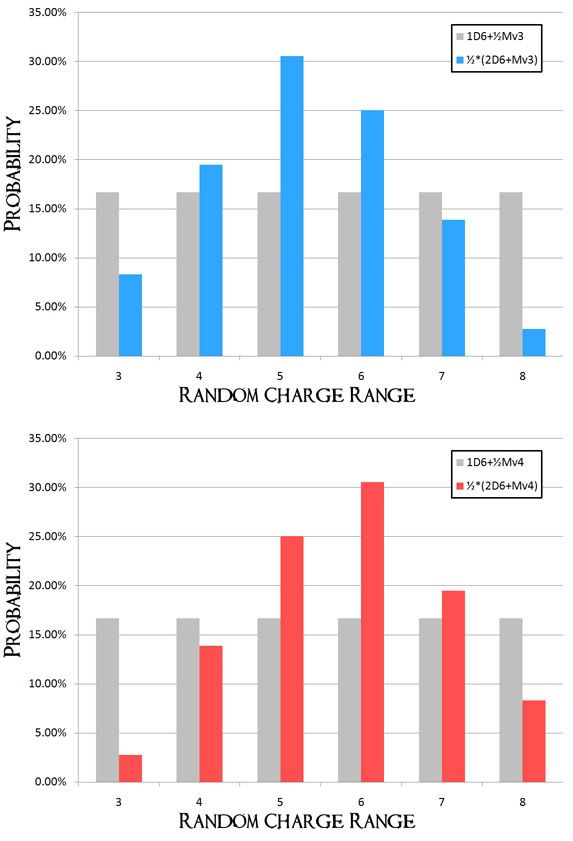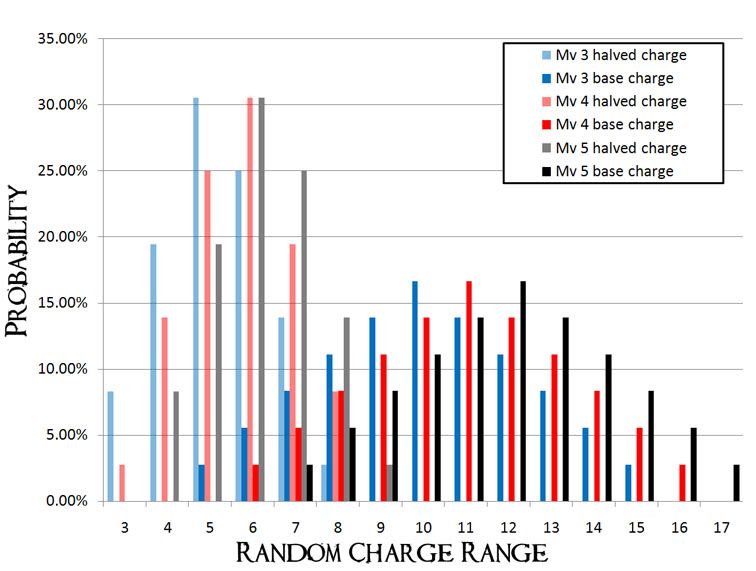Nicodemus:
Further to this thread on the Earthshaker in 8th:
My Chaos Dwarf Arcane Engineers have been looking over their calculations and have prepared some updated technical specifications for our Earthshakers under the new Rule of Law.
Targets hit by Earthshakers move at half rate, and this effects all movement, including charges, pursuits, etc.
There are important conceptual differences, however, under 8th Edition with regards to the Random Charge rule - where charge ranges are normally resolved with 2D6+Mv. It is folly to insist that affected targets charge 1D6+½Mv, as opposed to ½*(2D6+Mv).

Keep in mind that fractions are rounded up, so the halved rate for Mv 3 and Mv 4 models is the same (3-8"), but the probabilities are altogether different. Probabilities for Mv 3 models are skewed toward the lower side, whereas Mv 4 models are skewed higher, but the range is the same. In any event, the probability curves for 1D6+½Mv versus ½*(2D6+Mv) are completely different and this is worth bearing in mind for those Dawi Zharr Generals who wish to field these warmachines. Your opponents may not short-cut the range rolls by rolling 1D6+½Mv, as the probability curve is flat, whereas ½*(2D6+Mv) preserves the original probability distribution. Rolling 1D6+½Mv makes an 8" range as equally likely as 5" or 6", and totally negates the real difference between Mv 3 and Mv 4 units.
My brethren - do not allow the foes of the Dawi Zharr Imperium to roll 1D6+½Mv. The damned Dawi will benefit in particular from this contemptible practice, and we will give them no quarter! Their bones and flesh will fuel our forges and warmachines yet!

For Hashut!
Thommy H:
You move half your total move, whatever that might be. So, for a charge, it would be (M+2D6)/2. This was the original intention of the FAQ, so as interesting as these calculations are, it’s kind of a moot point!
Nicodemus:
so as interesting as these calculations are, it's kind of a moot point!
Thommy H
I agree with you that for charges (M+2D6)/2 is the correct value. I wholly disagree that the point is moot... it's a reminder to everyone that (M+2D6)/2 [or as I wrote it ½*(2D6+Mv)] is not the same as some might suggest, such as 1D6+½Mv. I had a very quick friendly game on the weekend and my opponent seemed to think that it didn't matter - whether it didn't matter because he didn't care or because he was clever enough to know he could get a better charge I won't guess.
I don't need everyone to tell me I was right, that's not the point of this thread. I stand by this post as an exercise, because somebody had to go through this to demonstrate to everyone
exactly what the difference is and how different the two are - both conceptually and numerically. These kinds of shortcuts with rolling fewer dice and adding factions of a stat to them are common mistakes related (I believe) to not fully understanding the inherent probabilities that are (often) meant to be preserved.
Hashut’s Blessing:
I think it’s interesting to look at and can easily be useful to show to opponents that they are incorrect and explain why it does make a difference.
It is just a good way of illustrating WHY it is important to differntiate between (2D6+M)/2 instead of just halving the values D6 + M/2 (or even 2D3 + M/2 or whatever, even though that’s not on this chart  ).
).
Thommy H:
I wholly disagree that the point is moot... it's a reminder to everyone that (M+2D6)/2
Yes, but as the person who wrote that particular FAQ, I could have just told you how it's supposed to be played. Anyone who is halving the component parts of the random movement for some reason is actually just doing it wrong, whether it gives them an advantage or not.
Like I said, I appreciate the maths and the graphs that shows us the difference, but the intention was always for it to be done in the way that makes the most sense according to the wording of the FAQ. I don't know why anyone would insist on halving the dice roll and then the Move value and then adding that together - it seems a very illogical way of doing it and, as you've detailed, actually gives the victim an advantage.
Perhaps it's worth clarifying this in the FAQ though?
Gar Shadowfame:
Just occured to me, and only Ravening Hordes halves whole charge, Indy shaker specificaly halves Movement value, so M4 charge is 2D6+2.
Nicodemus:
Perhaps it's worth clarifying this in the FAQ though?
Thommy H
Not a bad idea Thommy H, it certainly couldn't hurt, then there's no room for disagreement. I can see how even having the printed FAQ and letting your opponent read it could still lead to disagreement, people like to interpret deliberately-worded rules in interesting ways - which, as Warhammer players, we know all too well ;)
Just occured to me, and only Ravening Hordes halves whole charge, Indy shaker specificaly halves Movement value, so M4 charge is 2D6+2.:(
Gar Shadowfame
Another good point, and a good reason to a) make an explicit example in the RH FAQ to avoid confusion for those playing both lists, and b) carefully re-interpret how the Indy list functions in 8th... I forgot about this difference actually... good catch Gar!
Although it doesn't apply to this specific case I've argued similar points in other Warhammer games and indeed other board games because some people just can't wrap their head around how two ways of rolling and adding sums could possibly be different. A common mistake is that some folks first add up the totals, see the max and min are the same and fool themselves (for example, above the range is still 3-8"). Doubling a result is often another good one ;) Again, this was an exercise, and one I wanted to do for myself anyway. My only hope is that even one other Chaos Dwarf General catches this before it creeps into their games.
Only slightly off-tpoic - I'm all for playing correctly and by the rules, but I find rules lawyers annoying,
especially when it's me, I can hear myself talking and I want to shut myself up. In recent years instead of arguing my own point to someone who I feel is being obtuse and who starts to get pissy I let them happily roll the way that keeps them playing in a friendly manner and then talk to them about it after the game... or if I've lost I keep my mouth shut until next time because it comes across as bad sportsmanship.
Gar Shadowfame:
in Poland we have semi official league of umpires, 5 guys chosen by all gaming clubs in the country (that have organised at least 2 tournaments in a gaming season) that clarify lots of rules, sometimes even change them to make game more playable, and its semi official in all major and 80% of smaller tournaments. Whole point of this gyus is to create playable game and resolve all blury areas so everyone knows the rules. Its easier than rolling 4+ every other battle just because someone is poor reader:(
Hashut’s Blessing:
Thommy H: Very good point, but I was just talking about in general, for those that haven’t bothered to read the FAQ or don’t believe it to be good enough for them (even though it’s just clarifying things, rather than changing them). The main point that people can use to correct those trying to use the incorrect halving method is to point out the correct maths.
Maybe, in the FAQ, just word as: When asked to halve a randomised value (such as 2D6+4), you work out the whole value and then divide it by two.
Or something to that effect. If you want a citation, you can use the thread link for here and cite mathematics.
Gar: Pretty sure that the FAQ is intended purely for the Ravening Hordes list and the developers of the Indy GT list are updating that to fit into the new ruleset (maybe including an FAQ).
Nico: I know what ya mean about rules-lawyering, but I tend to only do it when somebody is trying to play completely the wrong way or in a particularly unfair manner (such as trying to measure before charging in 7th edition or measuring to see if they were in charge range of my units AFTER moving, then moving half an inch back


 ).
).